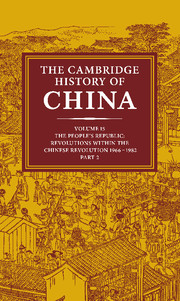Book contents
- Frontmatter
- 1 Mao Tse-tung's thought from 1949 to 1976
- PART I THE CULTURAL REVOLUTION: CHINA IN TURMOIL, 1966–1969
- PART II THE CULTURAL REVOLUTION: THE STRUGGLE FOR THE SUCCESSION, 1969–1982
- PART III THE CULTURAL REVOLUTION AND ITS AFTERMATH
- PART IV LIFE AND LETTERS UNDER COMMUNISM
- 9 The countryside under communism
- 10 Urban life in the People's Republic
- 11 Literature under communism
- PART V THE SEPARATED PROVINCE
- Epilogue: the onus of unity
- Appendixes: meetings and leaders
- Bibliographical essays
- Bibliography
- Index
- Map 1: China’s physical features
- Map 2. PRC: political (Wade–Giles romanization)
- Map 3. PRC: political (pinyin romanization)
- Map 7: Population
- References
10 - Urban life in the People's Republic
from PART IV - LIFE AND LETTERS UNDER COMMUNISM
Published online by Cambridge University Press: 28 March 2008
- Frontmatter
- 1 Mao Tse-tung's thought from 1949 to 1976
- PART I THE CULTURAL REVOLUTION: CHINA IN TURMOIL, 1966–1969
- PART II THE CULTURAL REVOLUTION: THE STRUGGLE FOR THE SUCCESSION, 1969–1982
- PART III THE CULTURAL REVOLUTION AND ITS AFTERMATH
- PART IV LIFE AND LETTERS UNDER COMMUNISM
- 9 The countryside under communism
- 10 Urban life in the People's Republic
- 11 Literature under communism
- PART V THE SEPARATED PROVINCE
- Epilogue: the onus of unity
- Appendixes: meetings and leaders
- Bibliographical essays
- Bibliography
- Index
- Map 1: China’s physical features
- Map 2. PRC: political (Wade–Giles romanization)
- Map 3. PRC: political (pinyin romanization)
- Map 7: Population
- References
Summary
When the Chinese Communists swept to power in 1949, they rapidly went from being a movement controlling large tracts of the Chinese countryside to a central government having to digest and manage the complexities of China's urban centers. China's new leaders were not, of course, country bumpkins: Most had had considerable urban experience before they took to the hills in 1927. Still, the task of bending the cities to suit the programs of the new government appeared formidable. For cities had been not only the center of power of the Chinese Nationalists but also the focus for much of the foreign influence that had streamed into China over the previous century. Their cosmopolitan natures made it appear difficult to transform them to suit the populist ideals of China's new rulers. Indeed, some urban elites and foreigners complacently assumed that their positions would not be threatened, because the Chinese Communists could not possibly run power stations, manage foreign trade, and deal with all the other complexities of urban life without relying on them.
This complacency turned out to be misguided. The Chinese Communists attempted to transform urban institutions and social life in fundamental ways. The record of this effort of urban transformation is mixed. In the short run the accomplishments of the new government were impressive. Many seemingly insuperable obstacles and immutable behavior patterns were overcome. In the long run, though, the difficulties of managing Chinese urban life gave rise to new problems and crises that organizational skill and ideological zeal alone could not resolve.
Keywords
- Type
- Chapter
- Information
- The Cambridge History of China , pp. 682 - 742Publisher: Cambridge University PressPrint publication year: 1991
References
- 2
- Cited by

